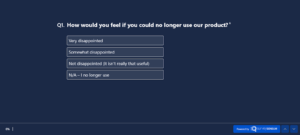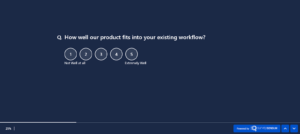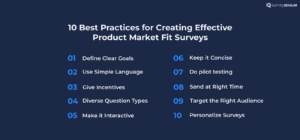9 Ways to Improve NPS Response Rates
Read More

Every business aims for the perfect product that customers adore. Take Apple, for example, who just launched products as per the market i.e., its latest iPhone 15 and sleek smartwatches. Apple continuously introduces products that not only excel but also cater to their customers’ desires. This fosters unwavering loyalty turning them into devoted fans.
You can achieve this by launching product-market fit surveys. To do this effectively, you require a comprehensive product feedback platform that can guide you through every step to create product feedback and do the analysis.
Not just that. You also have to consistently deliver the same outstanding experience to your all customers. This will not only acquire new customers but will also help you to retain your existing SaaS customers.
In this blog, we’ll delve deep into the concept of product-market fit, exploring how you can attain it and pave the way for your business’s success.
Let’s understand what is the meaning of product market fit.

Product-market fit is when your product is exactly what a specific group of customers wants. It’s a state where your product not only meets but exceeds your customer expectations, making it the preferred choice amongst the alternatives.
And when your product achieves product-market fit, you can not just acquire new customers but also increase customer retention and satisfaction leading to sustainable growth and profitability.
Now let’s explore why measuring product-market fit is crucial.
Measuring product-market fit is crucial for businesses because it tells you:
This helps you understand whether your product meets the needs of your target customers, informing product development, marketing, and sales strategies.
In this product-market fit journey, surveys play a vital role in understanding product-market fit, offering valuable insights directly from your target audience. They help you collect customer feedback, analyze the gathered quantitative and qualitative data by Text Analytics software, segment customers for personalized product development, and ongoing progress tracking for continuous improvement.
There’s one standout survey that assesses product-market fit → product market fit surveys.
Let’s understand what are these surveys.
Product Market Fit surveys, often abbreviated as PMF surveys are designed to evaluate how well your product fits into the market.
These surveys ask customers about their satisfaction, likelihood to recommend, and continued use of the product. The goal is to see if the product meets customer needs and is likely to be successful in the market.
The question that you should ask in PMF surveys is – ‘How would you feel if you could no longer use this product?’
Launch Your Product Market Fit Survey – Sign Up For Free
But how will you measure it? Find it out here.
Measuring product-market fit involves various metrics such as customer satisfaction, customer churn, changes in the CLV, or engagement levels. Among these metrics, the PMF survey is one of the quickest and most accessible methods for any business. And there are two ways to measure this survey:

One effective approach for measuring product-market fit is the Sean Ellis test. It involves a straightforward question – How would you feel if you could no longer use the product?
Your customers can choose from three response options:
By analyzing these responses, you can gauge the emotional connection customers have with your offering.
For example, if more than 40% of surveyed customers respond with “very disappointed,” it indicates a strong product-market fit. In this scenario, your product resonates well with the target audience, and they would genuinely miss it if it were no longer available.

The second way to measure PMF surveys is by using comprehensive CSAT surveys that explore various aspects of customer satisfaction with your product. These questions include features, usability, and overall value. This method aims to provide a deeper understanding of how customers utilize your product and their sentiments toward it.
Here are some examples of asking a series of CSAT questions:
And the response options can be on a Likert scale:
Let’s say after analyzing the survey responses, you find that 80% of customers are either “very satisfied” or “satisfied” with your product’s features, usability, and value. This shows a positive product-market fit, as most customers express satisfaction with your offering.
This is how both methods offer valuable insights into how well your product aligns with your target audience’s needs and preferences.
Achieve Product Market Fit with SurveySensum – Request a Demo
Now comes the questions that you can ask in your surveys to gauge customers’ experience and expectations.
Here are 10 questions you should ask to measure the fit of your product in the market:
These questions can help you gather valuable insights about your product’s market fit, customer satisfaction, and areas for improvement.
But wait, do you know how big should be the sample size of your PMF surveys?
When it comes to conducting a product-market fit survey, the sample size you need can vary based on your target market’s size and your desired level.
A general guideline is to aim for a sample size of a minimum of 40-50 respondents. This ensures that your survey results are statistically significant and can provide meaningful insights into your product’s market fit. However, in larger target markets, you want to consider a larger sample size to enhance the accuracy and reliability of your findings.
So make sure you thoroughly research your market before conducting the survey.
And now let’s dive in to find out the best practices for creating effective PMF surveys.

Here are ten best practices to ensure your PMF surveys deliver actionable results:
These practices will help you design effective PMF surveys, gather valuable insights, and make data-driven decisions to enhance your product-market fit.
Achieve Product Market Fit with SurveySensum – Request a Demo
Deploying PMF surveys at the right time is very important because of the following:
That’s how you do it. But there are certain pitfalls that you must avoid.
You should steer clear of common mistakes to obtain accurate and valuable feedback. Here are the following mistakes that you should avoid:
By sidestepping these common missteps, you can create an effective PMF survey that garners valuable insights and drives improvements in your product or service.
The crux of it is that you should use PMF surveys to improve your product and achieve the market fit for your product to drive business. And don’t forget to follow the best practices to effectively launch these surveys and get the most lucrative results.
So, start surveying and enhancing your product to excel in the competitive market. If you’re unsure of which survey platform you should use to leverage these surveys then explore SurveySensum. It is one of the best tools that can assist you thoroughly from creating surveys to launching them and viewing the real-time reports on their bird’s eye view dashboard.
Product market fit survey questions help assess whether your product aligns with your target customers’ needs. Here are the following examples:
Testing for product market fit involves various methods:
The 40% rule of product market fit indicates that if over 40% of your customers would be “very disappointed” without your product, you likely have product market fit. This rule stems from the Sean Ellis test, which gauges customer satisfaction. If a significant portion of your customers expresses high satisfaction, it suggests your product meets their needs and has achieved product market fit.
